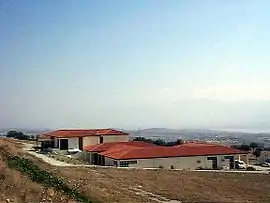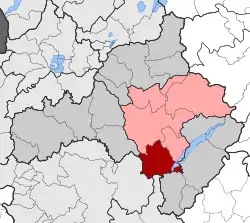Aiani
Aiani (Greek: Αιανή,[2] before 1926: Καλλιανή - Kalliani[3]) is a town and a former municipality in the Kozani regional unit, Macedonia, Greece. Since the 2011 local government reform it is part of the municipality Kozani, of which it is a municipal unit.[4] The 2011 census recorded 2,006 residents in the village and 3,429 residents in municipal unit of Aiani.[1] The municipal unit has an area of 156.004 km2, the community 52.336 km2.[5]
Aiani
Αιανή | |
|---|---|
 | |
 Aiani Location within the regional unit  | |
| Coordinates: 40°10′N 21°49′E | |
| Country | Greece |
| Administrative region | West Macedonia |
| Regional unit | Kozani |
| Municipality | Kozani |
| • Municipal unit | 156.004 km2 (60.233 sq mi) |
| Population (2011)[1] | |
| • Municipal unit | 3,429 |
| • Municipal unit density | 22/km2 (57/sq mi) |
| Community | |
| • Population | 2,006 (2011) |
| • Area (km2) | 52.336 |
| Time zone | UTC+2 (EET) |
| • Summer (DST) | UTC+3 (EEST) |
| Postal code | 500 04 |
| Area code(s) | +30-2461-xxx-xxx |
| Vehicle registration | KZ |
Name
It took its name from the Aianus (Ancient Greek: Αἰανος). According to the Greek mythology Aianus was the son of Elymus.[6]
History
Aiani was the capital of Elimiotis, a kingdom and region of Upper Macedonia, which became part of Macedon.
Since 1983, systematic excavations in the area have brought to light finds that attest the existence of an organised city from the late 6th century BC to 100 BC. These are now housed in the Aiani Archaeological Museum. The excavations in the city of Aiani, brought to light the oldest pieces of matt-painted (black and white) pottery ever found. Some of the matt-painted pottery dates back to the 15th-14th century BC (Μycenaean era). Amongst the archaic pottery, some of the oldest samples of writing were found. Amongst them we have names inscribed like ΔΟΛΙΟ (DOLIO) and ΘΕΜΙΔΟΣ (THEMIDOS), which prove that the society of that region of Macedonia, spoke and wrote Greek before the 5th century BC.[7][8] A single example of linear writing similar to that of southern Greece has been found, but its significance still remains unknown.[9]
Communities
The municipal unit Aiani is subdivided into the following communities:
References
- "Απογραφή Πληθυσμού - Κατοικιών 2011. ΜΟΝΙΜΟΣ Πληθυσμός" (in Greek). Hellenic Statistical Authority.
- Ancient Greek: Αἰανή Aianê - LSJ:aianês eternal
- Name changes of settlements in Greece
- Kallikratis law Greece Ministry of Interior (in Greek)
- "Population & housing census 2001 (incl. area and average elevation)" (PDF) (in Greek). National Statistical Service of Greece. Archived from the original (PDF) on 2015-09-21.
- Stephanus of Byzantium, Ethnika, A37.7
- Macedonia: Hellenism in Macedonia, Britannica Online
- The Late Bronze Age in Aiani, Aegeo-Balkan Prehistory
- G. Karamitrou-Menteside: Η Αιανή και η συμβολή της στην διαμόρφωση της νέας ιστορικής φυσιογνωμίας της Μακεδονίας - Εταιρία Μακεδονικών σπουδών, 2008 (Greek)
External links
- Archaeological Museum of Aiane: , , ,
- Necropolis of Aiani -Britannica Video
- Photos of the Macedonian Historical place at Aiani